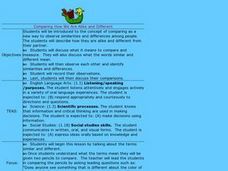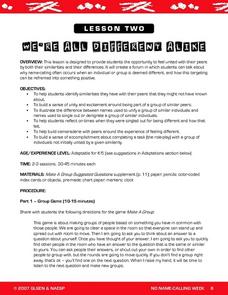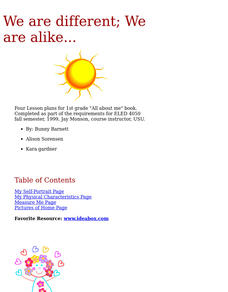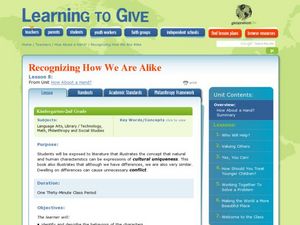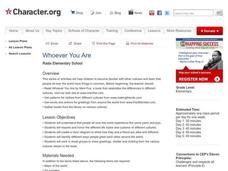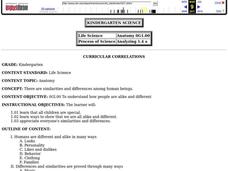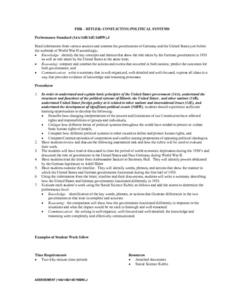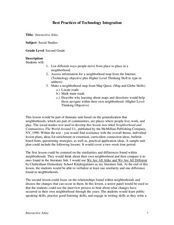Teaching Tolerance
Using Photographs to Teach Social Justice | Affirming Our Commonalities and Differences
Photos can challenge stereotypes. To gain an understanding of the big picture, groups examine a series of photographs and analyze how a photographer's choices can shape a viewer's reaction to an image. For the first set of photographs,...
Curated OER
The Flow of Women's Work: How Cultures are Alike and Different?
Students examine gender roles in various cultures. In this flow of women's work lesson, students compare water related work in rural Africa to that in their own households.
Curated OER
Comparing How We Are Alike and Different
Students introduced to comparing as a way to observe differences among people.
Curated OER
We are all alike, We are all different
Students investigate similarites and differences. In this multi-cultural lesson, students discuss how people are alike and how they are different by comparing apples to people.
Curated OER
Ways we are Alike/ Ways we are Different
Students complete a chart comparing and contrasting African villages with their own communities. The lesson focuses on the Mbuti and Fulani people. They explore their style of living, their traditions and everyday life in these villages.
Curated OER
We're all different alike?
Students identify similarities and differences that they have with their peers. They explore why name-calling often occurs when an individual or group is deemed different, and how this targeting can be reframed into something positive
Curated OER
We Are Alike, We Are Different:A Focus on Japan
First graders develop a connection with students in a first grade classroom in Japan. They begin to develop a curiosity about Japan--the landscape, the people, and their culture, while developing an understanding of the Five Themes of...
Curated OER
Where People Work
Students investigate where people work. In this social studies lesson, students use a Landscape Picture to locate places of work. Students discuss how each job is similar and different.
Curated OER
Landscape Picture Map: Natural and People Made Features
Students explore the places and objects that make up the Earth's surface. In this natural and people made features lesson, students identify things they've seen that are people made and those that are natural to the environment. ...
Foreign Policy Research Institute
Intro to China
Understanding the global interconnection between people of other nations is extremely important in our ever-shrinking world. Emergent global thinkers examine the significance of Chinese culture, religion, and political power. They then...
Curated OER
Acceptance Through Patchwork
Learners are asked to look at differences in people and accept those differences but to examine that people are more alike than different. The lesson has the central focus of investigating diversity.
Curated OER
Understanding and Fighting Stereotypes through Words and Images
Use some provocative modern art to get your class considering stereotypes and the impact they have on us all. Your class will discuss the print art Indian Look-Alike by Melanie Yazzie and stereotypes in general before...
Curated OER
Earth's Land and Water
Young scholars describe physical characteristics of bodies of water and landforms. In this land and water lesson plan, students model land and water with modeling clay and also discuss why people live near bodies of water.
Curated OER
Discrimination on the Menu
Students study discrimination in the workplace. In this discrimination lesson, students define the term 'fair' and work in groups to find ways all people are alike and different. Students write sentences defining a fair classroom, a fair...
Curated OER
We Are Different; We Are Alike........
First graders explain that everybody is unique in their own way by participating in this lively, art and language based series of lesson plans. They would greatly benefit from engaging in these plans in the beginning of the year as an...
Curated OER
Recognizing How We Are Alike
Young scholars explore the concept of social justice. In this service learning worksheet, students read The Sneeches in order to appreciate cultural uniqueness.
Curated OER
Cinderella in Africa
Explore African folk tales! After reading the African folk tale "Mufaro's Beautiful daughters" and the American version of "Cinderella," youngsters list differences and similarities between the two. Draw a T-chart on the board, and hold...
Curated OER
Whoever You Are
Students examine cultures, traditions, and feeling throughout cultures. For this cultural lesson, students use literature, maps, and cultural information to examine how people have universal feelings despite their different cultures and...
Curated OER
Where People Live- Neighborhoods
Students use a map. In this neighborhood activity, students describe a neighborhood, emphasizing the common characteristics between all neighborhoods. Students locate a neighborhood on a landscape picture map and discuss.
Curated OER
I Am Special and You Are Special Too #5
The student create a drawing of themselves through the use of multicultural people color crayons. They explain to a teacher what makes them special. Students investigate family types, skin color, eye color, hair color, and favorites.
Curated OER
Anatomy
Students explore the similarities and differences in human beings. They consider that all students are special, and appreciate everyone's similarities and differences.
Curated OER
FDR-Hitler: Conflicting Political Systems
Students compare and contrast the governments of the United States and Germany during World War II. Using different media, they identify the actions of both countries during the war and their major mistakes. They write a short summary...
Curated OER
Interactive Atlas
Second graders examine the different ways people move from place to place in a neighborhood. Using the interactive online atlas MapQuest, they identify the various ways people move around their own neighborhood by creating a map and...
Curated OER
Growing on My Own, Kids on the Grow
Students participate in an after school program that promotes critical thinking, concern for others, recognizing differences, accepting differences, self-motivation and personal safety. They cover how kids develop, expressing different...




